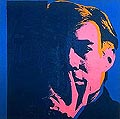|
 Andy
Warhol was born Andrew Warhola in Pittsburgh, Pennsylvania in 1928. In
1945 at the age of 17 he studied pictorial design at Carnegie Institute
of Technology (now Carnegie Mellon University) in Pittsburgh. Upon graduation,
Warhol moved to New York where he found steady work as a commercial artist.
He worked as a successful and distinguished illustrator for several magazines
including Vogue, Harper's Bazaar and The New Yorker. He also did advertising
and window displays for several retail stores includeing Bonwit Teller
and I. Miller. Andy Warhols first assignment was for Glamour magazine
for an article titled "Success is a Job in New York." Andy
Warhol was born Andrew Warhola in Pittsburgh, Pennsylvania in 1928. In
1945 at the age of 17 he studied pictorial design at Carnegie Institute
of Technology (now Carnegie Mellon University) in Pittsburgh. Upon graduation,
Warhol moved to New York where he found steady work as a commercial artist.
He worked as a successful and distinguished illustrator for several magazines
including Vogue, Harper's Bazaar and The New Yorker. He also did advertising
and window displays for several retail stores includeing Bonwit Teller
and I. Miller. Andy Warhols first assignment was for Glamour magazine
for an article titled "Success is a Job in New York."
Throughout the 1950s, Warhol gloried in great success as a commercial
artist. He won several awards from the Art Director's Club and the American
Institute of Graphic Arts. Andy Warhol shortened his name from Warhola
to Warhol. In 1952, Warhol's first show was at the Hugo Gallery, exhibiting
Fifteen Drawings Based on the Writings of Truman Capote. Warhol's work
was exhibited in several other venues, including his first group show
at the Museum of Modern Art in 1956.
The 1960s was an extremely prolific decade for Warhol. Warhol soon recognize
the importance of the mass media and took his early material from comic
strips and commercial advertisements which he found in tabloids like The
National Inquirer and The Daily News. Warhol created many paintings that
remain icons of 20th-century art, such as the Campbell's Soup Cans, Disasters
and Marilyns. At first Warhol concentrated on hand painted subjects of
mass consumption. Warhol used a projector to put the images on canvas.
He made it plain and simple and therefore was able to create the icons
of Pop Art. Warhol made several 16mm films which have become underground
classics such as Chelsea Girls, Empire and Blow Job. In 1968, Valerie
Solanis, founder and sole member of SCUM (Society for Cutting Up Men)
walked into Warhol's studio, known as the Factory, and shot the artist.
The attack was nearly fatal.
In
1962, he began to experiment with silkscreening images onto painted canvas,
a technique that allowed him to repeat a subject almost an infinite number
of times. His series with Elvis Presley, Warren Beatty, Natalie Wood and
other stars. In 1963, Warhol said in an interview that he wanted to work
like a machine.
The
start of the 1970s Warhol began publishing Interview magazine and renewed
his focus on painting. Works created in this decade include Maos, Skulls,
Hammer and Sickles, Torsos and Shadows and many commissioned portraits.
Warhol also published The Philosophy of Andy Warhol (from A to B and Back
Again). Firmly established as a major 20th-century artist and international
celebrity, Warhol exhibited his work extensively in museums and galleries
around the world.
He
started the 1980s with the publication of POPism: The Warhol '60s and
with exhibitions of Portraits of Jews of the Twentieth Century and the
Retrospectives and Reversal series. He also created two cable television
shows, Andy Warhol's TV (1982) and Andy Warhol's Fifteen Minutes for MTV
(1986). He also engaged in a series of collaborations with younger artists,
including Jean-Michel Basquiat, Francesco Clemente and Keith Haring.
Following
routine gall bladder surgery, Andy Warhol died on the 22nd of February
1987. In 1989, the Museum of Modern Art in New York showed a major retrospective
of his works. Five years later, the Andy Warhol Museum opened in Pittsburgh,
Pennsylvania.
|